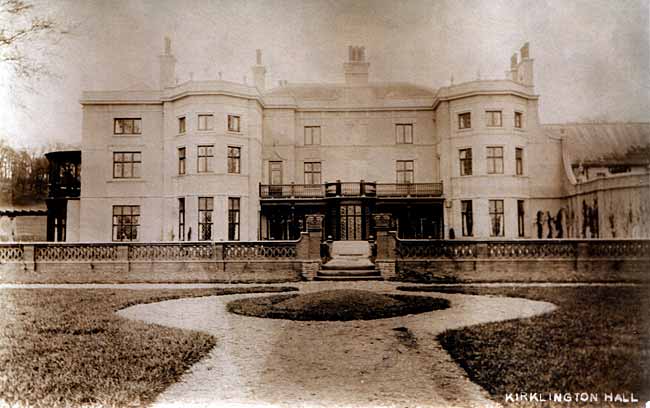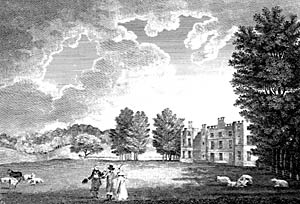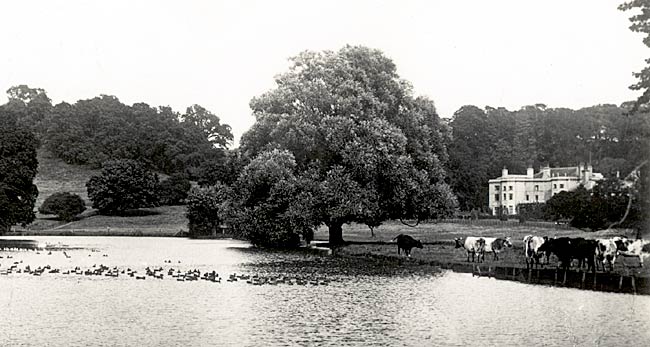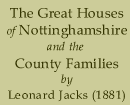< Kingston | Contents | Newstead >
Kirklington Hall

The west front of Kirklington Hall, c.1910.
THE report of a breechloader comes from among the trees on the well-wooded slope which shelters Kirklington Hall from the severity of biting winds, and redeems a stretch of country belonging to the house from the tameness which is sometimes associated with pastoral landscape. The career of a luckless rabbit is terminated, and the report rolls down the slope and dies away at a crescent-shaped lake, the noise being loud enough to cause a hatch of cygnets to crowd closer to their white plumed parent. The sports man is the representative of an old family, whose name has been associated with Kirklington for more than a century. Duly entered records in the College of Arms furnish proof of the connection of the Whethams with the Sotherons, and the representatives of the first-named family, who now own the soil here, ought to feel proud of that connection whenever they visit the chancel of Kirklington village church. The tablet which is intended to perpetuate the memory of Frank Sotheron, Admiral of the White Squadron of Her Majesty’s fleet, describes him as an intelligent landlord, a friend of the poor, a warm-hearted neighbour, and a most affectionate father. As a sailor, he had a character for courage, conduct, and ability, and “with these qualities he joined such engaging manners, such goodness of disposition, and unruffled temper, &c.’ The tablet publishes the fact that the Admiral represented the county in Parliament for nineteen years, and retired from public life in 1832, I suppose, to spend the rest of his days at Kirklington Hall, enjoying sweet air and fine views of wood and meadow, with those internal comforts which the headquarters of the owner of a large estate afford, and developing those superlative qualities with which his monumental biographer was so profoundly impressed. It is probable that Major-General Whetham, the only son of the Dean of Lismore, who served his Sovereign in the field, was severely wounded at the assault of Monte Video, and died at Kirklington Hall—his own home—had as many virtues as the Admiral, but there is no record of them on the church walls; and the simple tablet which serves to remind Kirklington church-goers of the late Colonel Boddam-Whetham, who died in Rome only a few years ago, and whose widow now holds and administers the estate, is an unobtrusive record of death, setting forth that the deceased was a magistrate for the county, and Colonel of the Sherwood Foresters, without note or comment.
Many, many years ago, Kirklington Hall was owned by a family named More, of whom also we are reminded by a near illegible tablet in the church, but more recent generations knew it as the residence of the Whethams. Most of the earlier members of the Whetham family, as well as those of the present century, followed the profession of arms; several of them have gained considerable distinction in the military branch of service, and some of them have served their country as members of Parliament. From a document that I had the privilege of inspecting, it seems that Nathaniel Whetham, in the early part of the year 1600, was a colonel in the Parliamentary Army, that he was afterwards governor of Portsmouth and M.P. for that borough, in 1655, and for the city of Edinburgh, in 1659. He was one of the council to the Lord Protector Oliver Cromwell, and as a mark of favour for his eminent services to the Parliament and the Commonwealth it was resolved that a sum of £200 per annum be settled on the Colonel and his heirs. The son of this distinguished personage, a barrister-at-law, married a daughter of Adrian Scroop, of Wormsley, in Oxfordshire, a colonel in the army, and one of the Council to Oliver Cromwell. The portrait of this gentleman, who, I believe, suffered death in 1660, is to be seen on the walls at Kirklington Hall to-day. Following up the pedigree we learn that Thomas Whetham, grandson of the governor of Portsmouth, was a lieutenant-general in the army and colonel of the 12th Regiment of Foot, governor of Berwick and Holy Island, and major-general and commander-in-chief of the forces in Scotland, in the absence of the Duke of Argyll and Earl of Stair. This gentleman’s son was the John Whetham who purchased the Kirklington estate, and whose remains lie in Hockerton churchyard ; his brother was John Whetham, First Commissioner of Excise, who died in 1737. In more recent times Arthur Whetham was a lieutenant-general and colonel of the 60th Regiment; lieutenant-governor of the forces in the south-western district, and groom of the bedchamber to the Duke of Cumberland. His brother, John Whetham, an officer in the 12th Regiment of Foot, was killed at the siege of Gibraltar ; the third and youngest brother of this generation was drowned at school. The present head of this old family, whose representatives in different times have filled so many distinguished positions is the lady who now owns Kirklington, Mrs. Boddam-Whetham, daughter of Colonel Whetham, and widow of the late Colonel Boddam-Whetham, well known in this county.

Kirklington Hall in the late 18th century. The house pictured here, embattled and with octagonal tower-like wings, was a remodelling of an earlier building. The hall was refashioned in 1904.
All the great houses of Nottinghamshire do not enshrine treasures of art or objects which legitimately come under the head of specialities. The internal aspect of one very much resembles that of another, and the life of one county family does not differ materially from that of another, One cannot be always describing the appearance of county drawing rooms, the quality of the furniture, the designs upon the wall papers, or making literary capital out of the contents of the conservatories. In a house like Kirklington, which is occupied by a numerically small county family—for two of the sons of the house are away, and the daughters are married—and on whose walls are a number of portraits about which nothing definite is known, what can one find to write about? Plenty. In these great country houses with their big rooms, comfortable and handsome furniture, and countless little treasures, the like of which one never sees in town mansions which have been built yesterday; with their beautiful pleasure grounds and immemorial trees, there is plenty to inspire the pen of a town dweller who lives in a street, and who, if he gives a supper party, has to consider whether his rooms will accommodate more than half-a-dozen guests. To describe Kirklington as a pretty place would convey to many of my readers an indefinite, but not an inaccurate idea of what it is. A big solid house, with white walls, which gleam through the surrounding trees; a house with a long drawing room, liberally ornamented, with a kind of door-window on one side, and an abundance of glass on the other; with a comfortable dining room, a library of fair proportions, a billiard room with appliances for playing that favourite game, and a suite of fine rooms upstairs—these are the main features of the house, and the same description would apply to other houses.

Kirklington Hall from the lake in the 1930s.
Going more into detail, one might say a great deal about the pictures, but, unfortunately most of these are mysteries of portraiture. A number of the portraits belonged to Admiral Sotheron, and Mrs. Boddam-Whetham does not know who those august personages in their antique costumes really are. In the dining room there is a portrait of one of the Whethams, by Wright, of Derby, who has limned him in the costume he wore on the occasion of some festivities when one of the Dukes of Portland came of age; and there is an old painting by an unknown artist, of Mr. Adrian Scroope, who was connected with the family by marriage. There are a few bright pictures in the drawing room, most of which have been sent from abroad, and in different parts of the house there are specimens of foreign art and spoils of far distant wood and forest, which have been sent home by the eldest son of the house. Weapons, stuffed birds of bright plumage, pictures, books, and a host of other things have been derived from this source. Mr. Boddam-Whetham has travelled much, and has written books on foreign lands. Outside there is much to charm the eye. There is a beautiful lake near the house, whose surface is flecked by animated snowflakes—white ducks of the purest plumage, and on a little island a pair of swans have brought up their downy brood. This lake is of picturesque formation ; the water is clear and quiet, and there is a fine meadow on the other side. The fishing rod with 1ash of flies, which stands ready-jointed in the porch leading to the entrance hall of the house, may be regarded as evidence that this sheet of water is not uninhabited, and if you watch for a while you may see the fish rising. The lawn about the house is smooth and well kept, and there is plenty of it. The trees are abundant and of almost endless variety, and the house is sheltered on one side by a range of hills well wooded and profusely foliaged. On the other side is the village, with its church, its small and substantial school, ifs picturesque cottages and more pretentious farmstead. The hall is really in the village, and some two hundred yards of gravel road, flanked by horse chestnuts and other tall trees, bring one within its precincts.
